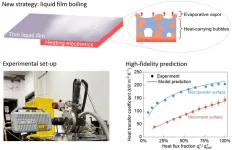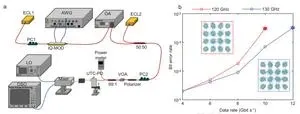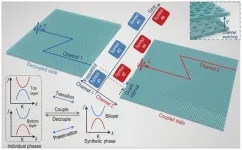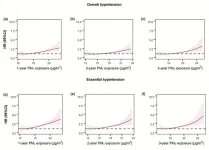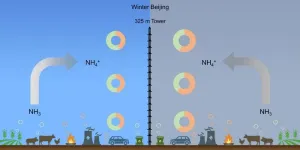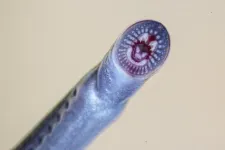High-fidelity model for designing efficient thermal management surfaces
2024-05-08
(Press-News.org)
In the past decade, fires from electronic devices and batteries, from small smartphones to electrical vehicles and airplanes, have repeatedly made headlines. Enhanced computational power has led to a large amount of waste heat generation and undesirable temperature rise of electronics. Poor heat management is the cause of over half of electronic device failures. To tackle this issue, it is crucial to develop advanced cooling technologies to effectively manage heat and maintain temperatures in the working conditions.
Among various cooling technologies, liquid-vapor phase-change cooling, which utilizes the boiling or evaporation of liquids, is gaining attention due to its superior heat dissipation ability. For instance, the immersion cooling method, similar to boiling water, immerses high-power electronic components in a liquid pool for cooling.
However, researchers have found that relying solely on either boiling bubbles or evaporation no longer meets heat dissipation needs of electronic devices. A few years ago, Yang et al proposed a new strategy that employs both evaporation and nucleate boiling and called it capillary-driven liquid film boiling (Wen et al Nano Energy, Vol.51, pp.373-382, 2018, ). This cooling technology generates boiling bubbles in an evaporative thin liquid film by a careful design of the wicking structured surface. This kind of wicking surface is often controlled with a thickness of less than 1 millimeter. Leveraging the benefits of both boiling and evaporation which have been well studies over a century, the new strategy of liquid film boiling achieves high heat dissipation performance, surpassing the heat dissipation limit of traditional phase-change heat transfer.
High heat transfer performance relies on delicate surface design. With the recent development of the micro-nano technologies, researchers are performing the studies on many micro/nano-structures surfaces to enhance heat transfer. However, current surface designs for liquid film boiling are typically based on experience and lack theoretical guidance. This is due to the complex liquid-vapor phase change process, which involves complicated dynamics of bubbles and liquid film, and the resultant heat transfer. The textured structures of different surfaces further increase the complexity, making the prediction of the heat dissipation capability a long-term challenge, therefore hindering the development of optimal surfaces.
In respond to this challenge, a team of researchers led by Professor Ronggui Yang at Huazhong University of Science and Technology in Wuhan, China, developed a high-fidelity model to predict the liquid film boiling heat transfer on various textured surfaces. Being able to predict not only heat dissipation but also surface temperature, the model can predict the heat dissipated through different phase change modes (evaporation or boiling). The model predictions for various textured surfaces agree well with experimental data.
The new model is expected to guide the design of new heat management surfaces. This is of great importance for devising high-performance cooling strategies for next-generation electronics.
###
See the article:
A heat transfer model for liquid film boiling on micro-structured surfaces
https://doi.org/10.1093/nsr/nwae090
END
ELSE PRESS RELEASES FROM THIS DATE:
2024-05-08
This study is led by Prof. Xu (State Key Laboratory of Integrated Optoelectronics, College of Electronic Science and Engineering, Jilin University), Prof. Yu (College of Information Science and Electronic Engineering, Zhejiang University), Prof. Han (Precision Instrument and Optoelectronics Engineering, Key Laboratory of Optoelectronic Information Technology, Tianjin University and Guangxi Key Laboratory of Optoelectronic Information Processing, School of Optoelectronic Engineering, Guilin University of Electronic Technology), and Prof. Sun ...
2024-05-08
Hypertension is among the leading cardiovascular diseases. Despite extensive research, evidence concerning the relationship between long-term exposure to ambient particulate matter and hypertension remains limited and inconsistent, particularly with regard to submicron particulate matter (PM1). While randomized controlled trials are considered the gold standard for causal inference, environmental epidemiological studies typically rely on observational data. Traditional approaches in observational studies are less effective than randomized controlled trials in fully controlling for confounding factors to achieve results with causal interpretability. With the advancement of causal ...
2024-05-08
Recently, Science Bulletin published a research conducted by Prof. Pingqing Fu and Dr. Libin Wu from Tianjin University, Peng Wang from Fudan University, and their Chinese and foreign collaborators. They explored the source of ammonium in PM2.5 at different heights of the atmospheric boundary layer in Beijing, and found that combustion-related ammonia is very important to ammonium in PM2.5 during haze pollution in winter.
Air pollution and treatment in Beijing have been widely concerned by both the scientific community and the public. Although its PM2.5 has decreased significantly in the past few years, there is still haze pollution in Beijing, especially in winter. The chemical compositions ...
2024-05-08
The researchers conducted a study over four days, including overnight stays, with 18 subjects at :envihab, the DLR medical research centre in Cologne. At a simulated altitude of 2500 meters above sea level, the influence of hypoxia (oxygen deficiency) on various hemodynamic and metabolic parameters was investigated. The central venous pressure via a catheter and the blood flow in the lungs using real-time magnetic resonance imaging were evaluated. The results showed that neither the pulmonarypressure nor the blood flow changed significantly. All patients able to tolerate a longer stay at altitude of 24 to 30 hours without complications.
Oxygenation ...
2024-05-08
The Australian brook lamprey (Mordacia praecox) is part of a group of primitive jawless fish. It’s up to 15 cm long, with rows of sharp teeth. Surprisingly, it doesn’t use these teeth to suck blood like most lamprey species – it’s non-parasitic.
As larvae, the Australian brook lamprey lives buried in the bottom of streams for around three years, filter-feeding. Its adult phase is about one year long, in which it doesn’t feed at all. Prior to this study – funded in part by the Australian Government through the National Environmental Science Program’s (NESP) Resilient Landscapes Hub – the species was widely believed to only live in a few streams ...
2024-05-08
A unique $3.7m plant lab will put researchers on the frontline in the fight against climate change and create crops for “tomorrow’s atmosphere today”.
The new flagship facility at the University of Essex will allow scientists to adapt plants for a hotter drier planet as food security is increasingly threatened.
It boasts a cutting-edge commercially standard vertical farm, an indoor field that replicates real environments anywhere in the globe, and suites that imitate a warming world – with researchers able to raise CO2 concentration and temperature levels at will.
Computer ...
2024-05-08
Scientists at the University of Surrey are developing a new way to power low-orbit spacecraft using – literally – thin air.
Surrey Space Centre aims to enable extremely low-altitude spacecraft orbits in the upper atmosphere, thanks to funding from the UK Space Agency.
This new spacecraft concept could offer new capabilities in Earth observation, climate monitoring and satellite communications.
Dr Andrea Lucca Fabris, principal investigator from Surrey Space Centre and an electric propulsion specialist, said:
“There are benefits to flying in very low altitude orbits, like being able to operate Earth observation at much ...
2024-05-08
The author of a disaster novel couldn't have dreamed it up any better: On a Friday, the thirteenth of all days, the potentially dangerous asteroid (99942) Apophis will come extremely close to humanity. On 13 April 2029, there will only be around 30,000 kilometres between the cosmic rock and Earth. It will then be possible to see Apophis with the naked eye as a point of light in the evening sky, even from Würzburg.
What makes the asteroid so dangerous: its average diameter is an impressive 340 metres. If it were to hit the Earth, the ...
2024-05-08
Research warns of hazardous health risks from flavoured vapes
Research predicts the potential formation of 127 acutely toxic chemicals in flavoured vapes
Findings underscore the urgent need for comprehensive regulation of vaping products
Wednesday, 8 May 2024: New research has uncovered the potentially harmful substances that are produced when e-liquids in vaping devices are heated for inhalation. The study, published in Scientific Reports, highlights the urgent need for public health policies concerning flavoured vapes.
The research team at RCSI University of Medicine and Health Sciences, Dublin, used artificial ...
2024-05-08
Three Florida Atlantic University researchers at the forefront of Alzheimer’s disease (AD) research have each received a $350,000 grant from the Florida Department of Health’s “Ed and Ethel Moore Alzheimer’s Disease Research Program.”
The Ed and Ethel Moore Alzheimer’s Disease Research Program was established to improve the health of Floridians by stimulating research into the prevention, diagnosis, treatment, care management and cure of AD.
Florida has the second highest incidence of AD in the nation with 580,000 people ages 65 and ...
LAST 30 PRESS RELEASES:
[Press-News.org] High-fidelity model for designing efficient thermal management surfaces
